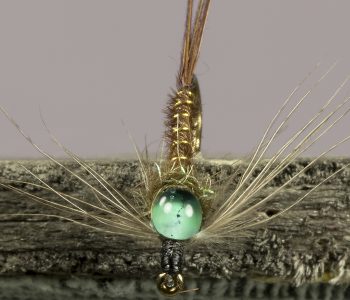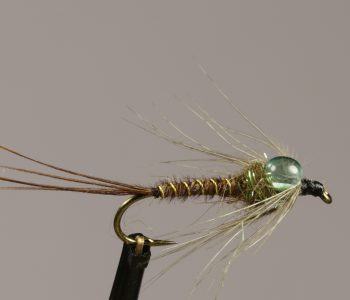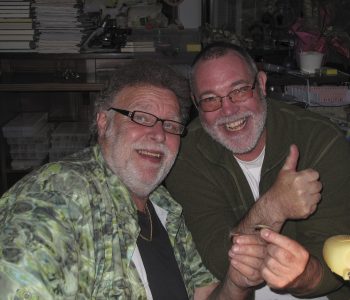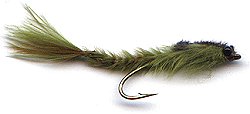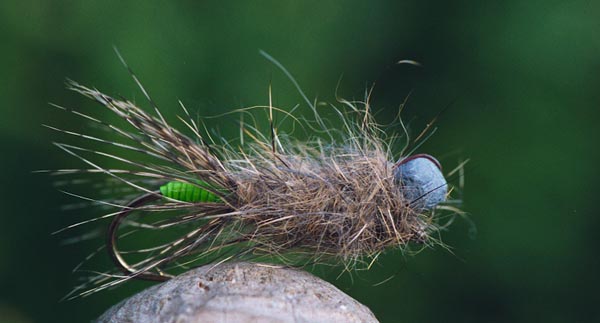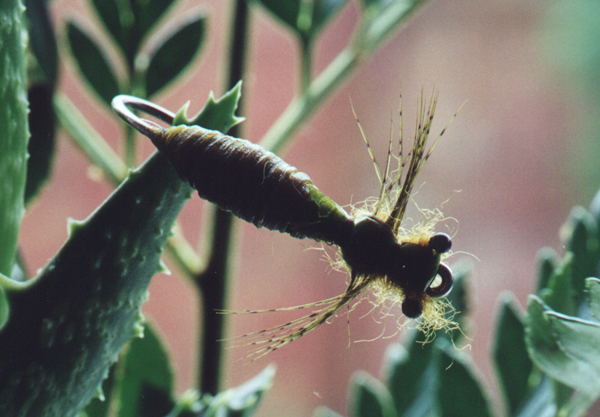
Hans de groot nymph
CDC an MP tying material by Leon Links
Just imagine the following: you are invited to fish for two weeks on a river after your own choice, no matter where on this planet. You may take along whatever you need, rods, reels, lines, everything, except for one thing..: flies!
However, instead of flies you can bring a vise, hooks, tying silk and one, only one tying material…but plenty of it as you will have to tie all your flies with it: nymphs, emergers, dry flies and streamers.
Well, what material are you going to take along…?!
Difficult question? It wouldn’t cause any problem to me at all. The one and only material – after my firm opinion – appropriate for taking up this challenge would be CDC. Cul de canard feathers are so versatile that you could easily make all parts of your flies with them: tails, bodies, hackles, wings, wing cases, legs etc. And also in a very convincing way. You can work up CDC in various ways like hackling the plumes, tying in complete feathers, dubbing the feather fibres etc.
I’m not the only one who finds that CDC is pre-eminently a (M)ulti (P)urpose) tying material. Many other flytyers are of the same opinion. In recent years I have intensively interchanged ideas and experiences with some twenty prominent flytyers from America, Japan, Italy, France and my own country who are widely known due to their excellent CDC patterns. I contacted them some years ago because I had started writing a book on CDC, and experienced that help from experts in this field was badly needed. In September 2002, at last, this book on the history of CDC, the masters, their patterns, tips and tying instructions etc etc was published by Merlin Unwin Books in England.

The most important of these tyers – without any doubt – is Marc Petitjean from Fribourg, Switzerland (www. Petitjean. Com) whom I visited several times for interviews. You won’t believe what he knows about CDC, the history, patterns etc. He is also the most skilful and innovative tyer of CDC flies I know. Marc has done incredibly much for the development of CDC tying techniques and the ever increasing popularity of CDC. In the late 1980s he presented a wonderful series of flies tied with CDC only which made his name as a professional flytyer. In the years thereafter he introduced his new patterns annually, and now, anno 2002, he has a comprehensive collection from which flies can be chosen for each fishing situation. Typical features of all his flies – both dry flies and sub surface flies – are the subtle designs and the fact that all of them are tied of 100 % CDC.
Own experiments
The best thing that happened to me in almost twenty years of flytying is discovering CDC as a tying material. I learned to appreciate it over the years designing patterns and fishing them in all kind of fishing situations. CDC is a wonderful material suitable for tying small, subtle flies that can seduce suspicious fish but also for large flies that still seem to be delicate and transparent. Besides that I find it a fascinating idea that CDC can be used in so many different ways and that almost all parts of the natural fly can be adequately imitated with it.
In some of my patterns devised in the past few years I always use CDC. On the one hand because I have been inspired by the work of others, especially Marc’s; on the other hand because CDC flies -my own and those of other tyers too – improved my catch rates considerably, in spite of difficult fishing every now and then. All this encouraged me to go on experimenting.
I met with difficult fishing in Belgium and France many times, and in the past few years in Slovenia sometimes too. Here I fished in the area around the village of Most na Soci, ideal operating base for a trip to the fascinating Soca, princess of the mountains, and her fantastic tributary Idrijca.

The Baca, Kneza, Tolminka and Trebuscica, other challenging rivers and streams in the region too didn’t make things easier for me. All waters here have in common that they are extremely clear. Sometimes it is possible to spot bottom feeding fish in pools of over four meters deep. Difficult fishing demands the utmost of the flyfisher, not only regarding casting and fishing techniques but certainly also regarding his (or her) knowledge of insects and imitating them behind the vise. In order to make a chance at all and have successful fishing it is necessary to fish with good imitations of present naturals like mayflies, stoneflies, ants and sedges that fish feed on. Good imitations have the right size and silhouette, they look delicate and provide action. CDC will help you to realize these triggers.
Marjan Fratnik and the F Fly
Most of us meet with new rivers and still waters to fish on from time to time. The best possible way to get familiar with these new waters is when you are guided by local fishermen,preferably those who are experienced flyfishers and know the area like the back of their hand. I was so happy to have the opportunity to fish the rivers around Most na Soci with my friend Marjan Fratnik who was born in the village in 1919 and caught his first trout on the fly at the junction of the Baca and Idrijca in 1935!
Marjan Fratnik is a wellknown name in flyfishing due to his articles, contacts and last but not least his revolutionary F Fly. In the early 1980s Marjan became the father of all modern CDC tying by working with CDC feathers in a completely different way than everyone before him. In stead of hackling the plume he just tied it in backwards over the hook thus creating an astonishing simple but in the same time very effective fly. Marjan devised his F Fly for fishing his beloved waters around Most na Soci and tested it here with great success.
The F Fly and variations are known as exceptionally effective, not only in Slovenia but world wide. Why? For a few reasons I think. At first because it floats in the film, at second because it imitates a whole range of insects like sedges, stoneflies and all kind of emerging mayflies. And there is another reason: it is made with CDC. So it is soft and transparent, and therefore very insect like.
My experiences with the F Fly in Slovenia are positive. But other ‘ in the surface’ patterns like Van Klinken’s Klinkhåmer Special, his Once & Away, our mutual parachute Rhodani imitation and my own L Compara and Caddis patterns did very well for me too. This inspired me to tie many more experimental in the film floating flies. And sometimes a useful fly is the outcome.
Hans de Groot Nymph
A relatively new pattern of mine that caught a lot of fish on slower parts of the Idrijca and Baca in the last few years is the Hans de Groot Nymph. It is an in the surface floating nymph named after Holland’s flyfishing personality and greatest fly dresser ever, the late Hans de Groot. I also call this pattern HdG Nymph or simply De Groot Nymph. I tie this nymph with flexibody a very useful synthetic material in various colours and with CDC. I fish it in the film or just below the surface most of the time. Sometimes I fish it deeper with the help of split shots. This fly’s success is probably due to its good silhouette and lifelike CDC action.
Flexibody was re-introduced on the market by master tyer Oliver Edwards in a number of new attractive colours. Flexibody is fit for making smooth abdomen of certain may fly species and the backs of Gammarus species. Hans van Klinken uses it for his Caseless Caddis one of my favourites.
Tying the Hans de Groot NymphDressing
Hook: Tiemco 200 # 8 – 16
Tail: CDC fibres
Abdomen: Flexibody
Thorax: Hare’s ear and CDC
Thorax back: Peacock strip


3. Tie in the strip at the base of the tail

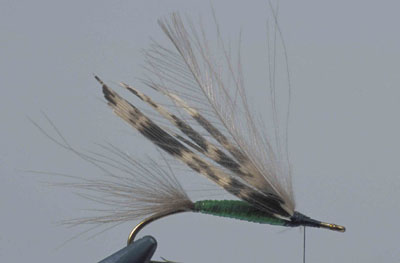

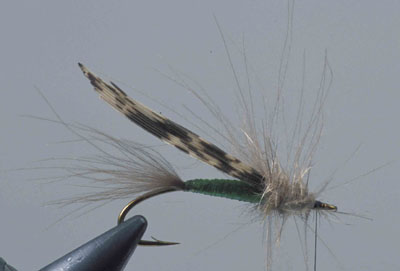
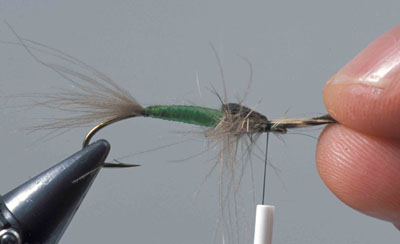

Combining CDC with other materials
I am a true addict of CDC but I also appreciate other materials -both natural and synthetic- for combining them with CDC. I think my Hans de Groot Nymph is an example of a very nice combination. Another prominent tyer who has been very important for the development of CDC tying techniques is Gerhard Laible from Germany. He never was an advocate of ‘CDC only’ patterns. From his first articles on tying CDC flies in German flyfishing magazine Der Fliegenfischer he always combined CDC with other materials in order to use their specific features. Examples of two of these composite patterns are his GL Adult Stonefly with synthetic wings, and his GL Fluttering Stonefly with deer hair wings.

CDC is a fantastic material that has caught attention of many flyfishers in the last decade. Naturally! It allows you to tie very effective flies. Still, many flyfishers only use a limited number of CDC patterns or don’t use them at all. In my recently published book ‘Tying flies with CDC’ I have tried to gather a lot of interesting information on the most important aspects of the subject. Maybe it is a good idea to take a look at it sometimes. Thanks for reading my article.
GL Adult Stonefly
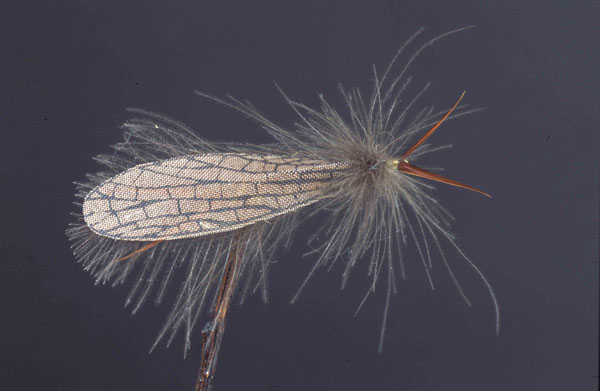
GL Fluttering Stonefly

Biography Lèon Links
Leon was born in 1953 in Dordrecht, Holland. He lives with partner and daughter in Zoetermeer and is a teacher of Dutch language and Dutch literature.
He started flyfishing for trout in 1965 in Norway and became a passionate flyfisher and flytyer ever since. He likes corresponding with his flyfishing friends all over the world, reading on the subject, shooting flyfishing and flytying pictures and writing articles for various magazines. Leon is a member of the editorial staff of the Dutch flyfishing magazine De Nederlandse Vliegvisser since 1997 and he has written -with the help of many others – a book on CDC flies published by Merlin Unwin Books, England in September 2002.
His favourite waters are to be found in Scandinavia, Belgium and Slovenia for trout and grayling fishing, and at home in Holland for white fish and pike fishing (with flies but that goes without saying).


